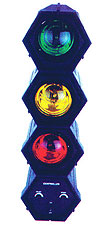Traffic lights are a set of colour coded signals installed at busy road intersections or junctions. Traffic lights go by a wide range of names indifferent countries e.g. stop lights, stoplight, traffic lamps, stop-and-go lights, robots etc; these are signalling devices positioned at the otherwise busy intersections, pedestrian crossings and other locations to control competing flows of traffic.


Traffic lights are a set of colour coded signals installed at busy road intersections or junctions.
Traffic lights go by a wide range of names in
different countries e.g. stop lights, stoplight, traffic lamps, stop-and-go lights, robots etc; these are signalling devices positioned at the otherwise busy intersections, pedestrian crossings and other locations to control competing flows of traffic.
Traffic lights have been installed in most cities around the world. They assign the right of way to road users by the use of lights in standard colours; the colours are Red for stop, Orange or amber for get ready and Green for go. These are designed to use a universal colour coding because, drivers and other road users from different
countries should easily know how to interpret them at just a glance.
In addition to a universal colour code, these lights have a particular sequence of events, e.g. after the Green (Go) light, there comes the Orange (Get Ready light), then follows the Red (Stop light), this sequence can be easily
followed by even those persons that may be colour blind in that, they have memorised the sequence of events.
The first four-way, three-color traffic light was created by police officer William Potts in Detroit, Michigan in 1920.
In modern traffic lights, they have incorporated arrows in the green lights in order to indicate the direction of the vehicles allowed proceeding; this serves to alert even
those that maybe colour blind as the two other sets do not have directional indications since they only serve as a alerts to stop and get ready signals.
A number of these traffic lights employ the LED (light Emitting Diode), new low energy type of miniaturised bulbs that arranged in large numbers so as to create a bright situation.
The LEDs are cheap and consume very low power such that, they can even work on Solar energy.
Secondly, they can be arranged to make desired patterns e.g. directional arrows in the "Green Light” and the "Cross” sign in the "Red light”.
This helps to alert even those with colour blindness. In many parts of the world, they employ a number of slightly different traffic signals, say in the USA, they have now developed the type that has a visual alert for the drivers, this tends to reduce the would be high rates of accidents in that, the driver knows when he is to go.
Under this category, the Lights are fitted with a digital countdown timer that indicates how many seconds are left to go.
Traffic lights use a set of indications to communicate and command suitable responses. These communications are standardised worldwide though they may slightly vary from country to country.
Traffic signal controls have three main components viz, the Sensors, Decision Making Logic, and Outputs.
Communication between intersections and with a central control is also used.
Technologies used to detect vehicles include: metal detectors (called loops), radar, and video.
The decision making logic is performed by a microprocessor (small computerized device) running a specialized software application. The program collects information from sensors and uses it to make decisions about normal cycling of the signal.
Traffic engineers use data collected from studies to determine how long the green and orange indications should be on.
Sensors also enable the program to decide how much green can be added when traffic demand is greater. Outputs are typically lighted indications which are by colour and shape. Shapes include circular (called Ball) lamps and arrows.
For pedestrians shapes include the Walking Man and the Hand though not extensive.
The basic components in the lights are Relays, these are logical electronic devices that control the flow of electricity from one direction to the other, and they are what the logical devices use to send or control the outputs to the displays.
The actual working of the lights is much more complicated than this though it runs on these lines.


